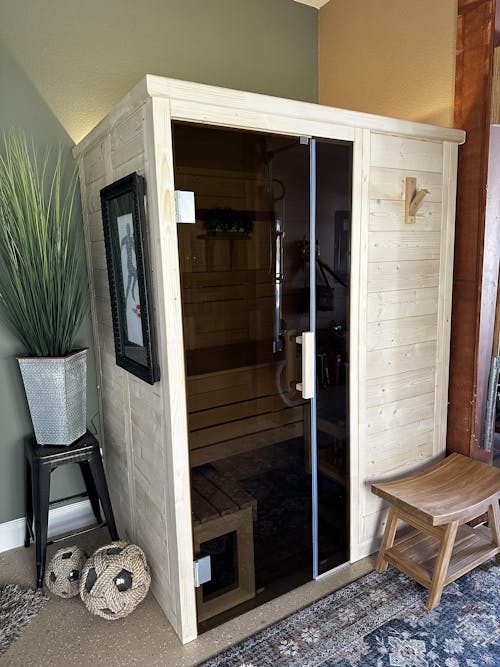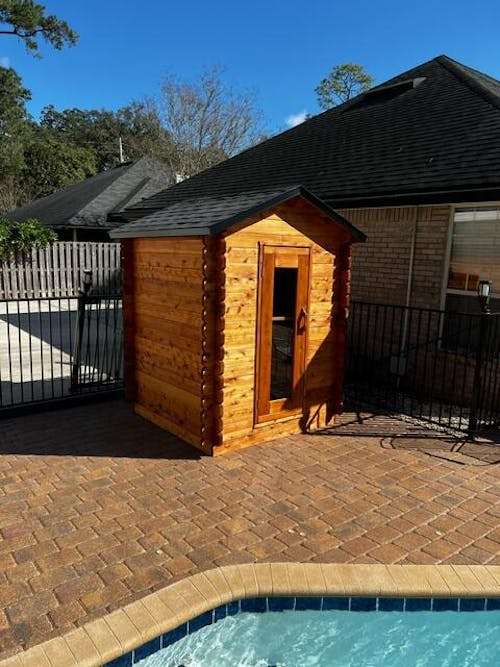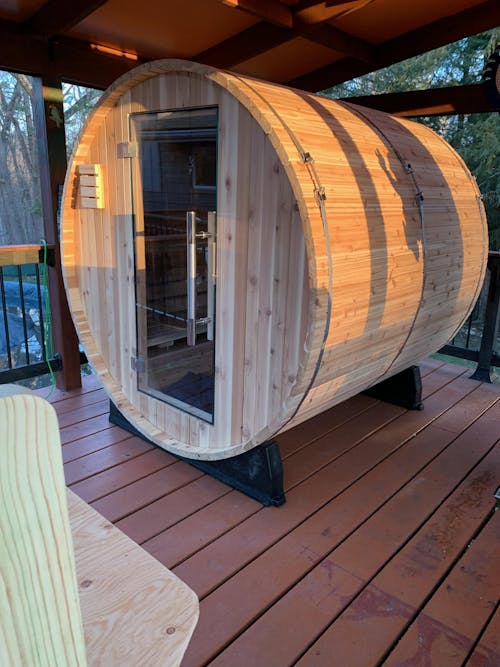THE ULTIMATE GUIDE ON CLEANING A SAUNA
After a long grind at work or training at the gym, relaxing in a sauna can be just the luxurious experience you need to unwind and de-stress. In fact, using a sauna is a centuries-old method that arose from humans using heat and steam for its health care benefits. Yet, how hygienic and reliable are these hot – and sometimes steamy – places?
Keeping your health in mind, this article will provide expert advice on how to keep your sauna clean, tips for deep-cleaning a sauna, as well as how to maintain it so you and your family can enjoy your investment for years to come.
First, Are Saunas Full of Germs?
When saunas are properly used and maintained, they can remain quite clean and will not cause harm or illness. However, when they go unused for long periods of time or are left neglected, a sauna can become a breeding ground for pesky microbes. Exposure to these microorganisms can result in many health risks, such as upset stomachs and skin problems, including bacterial infections, impetigo, and rashes.
Warm and humid environments are where harmful bacteria and microorganisms thrive. This is more likely in a steam room, rather than a sauna.
Saunas produce a dry heat and a low level of humidity. Traditional style saunas are warmed by a heater and sauna rocks, usually operating at a temperature of around 180 - 195 degrees Fahrenheit. Water can be sprinkled on the sauna rocks to produce steam and create a steam room experience, but the temperature will still be much higher than that of an actual steam room.

A steam room, on the other hand, are wet rooms that use generators and boiling water to make lots of steam. This means that they are quite humid, with levels as high as 100%. The temperature in a steam room is lower than that of saunas, usually 100 - 120 degrees Fahrenheit. Due to their warmth and humidity levels, steam rooms have a higher potential than saunas to be a breeding ground for germs and bacteria.
8 Use Tips for Maintaining a Hygienic Sauna
Here we’ll share 8 tips that will help you keep your sauna as clean as possible while you use it. If you follow these tips, you can maintain the aesthetic appeal of your sauna cabin while ensuring that your guests also follow a clean protocol.
-
Keep your feet clean: Make sure your feet are clean before using the sauna. It’s critical to wash your feet before entering or put on flip-flops so you don’t track in dirt and bacteria that can lead to mold.
-
Use a towel: Place a towel on your seat to absorb sweat and create a hygienic barrier separating you from the sauna seating.
-
Cover any injuries: Before using the sauna, treat and cover any wounds. If possible, do not use the sauna bath when injured.
-
Don’t use it when sick: A person with a cold may shed bodily fluids that could spread the illness.
-
Stay hygienic: Take a quick rinse and shower before and after your sauna session to ensure that you and your sauna remain clean.
-
Let in the air: Ensure that you get rid of extra moisture after using the sauna. After each usage, thoroughly ventilate your sauna and its area to clear the humidity. Tell other sauna users to leave the sauna doors open after use to improve ventilation and enable the room to dry out.
-
Wipe it down: Keep a handy brush beside the sauna entrance. After a sauna session, use the brush to wipe down backrests, walls, and benches. Wiping it down only takes a few minutes and will maintain your sauna in great shape for many years. If you don’t have a brush, a clean, damp cloth will do.
-
Use it regularly: The best way to keep your sauna free of mold and mildew is to use it regularly! Simply use it as a “dry” sauna and the high heat and lack of humidity will zap away any microorganisms that may be forming. Just be sure to use a towel on the benches to protect them from sweat.

Cleaning a Sauna
Saunas will need cleaning after prolonged usage. In case of regular use, we advise cleaning it once a month. The most effective saunas are those that are hygienic. Here are some quick and simple steps for cleaning a sauna and increasing your health and happiness. Before trying any of these deep-cleaning methods, be sure to wait until the sauna has cooled down and stopped running before cleaning it!
Basics of Cleaning a Sauna: Soaping and Mopping
If you use your sauna frequently enough, you might wish to give the floor a deeper clean. A mild detergent and warm water can clean stains left behind by dirt tracked into your sauna. Use a light, chemical-free, liquid deodorizing cleaner to mop the floors of your sauna to keep it looking and smelling fresh.
-
Avoid harsh cleaning agents: Do not use chemical cleaning agents on wood. They might bleach the wood, ruining the surface permanently.
-
Use proper sanitization methods: Since sauna wood is extremely dry and sensitive to moisture, do not sanitize with a high-pressure washer or a water hose.
-
Use soft water: You might never need to use anything else to cleanse the wood elements of your sauna if you clean it every time while using pure water rather than hard water.
-
Keep airing it out: After you've cleaned your sauna, let it air out. Leave the sauna door open as you leave so that it may ventilate and stay fresh. The interior will ultimately dry out completely.

Cleaning a Sauna with Eco-Friendly Supplies
Traditional cleaning supplies are hard on your sauna benches, and can be harmful to humans and the environment. There are many easy and safe techniques to clean your sauna, with ingredients readily available in every home. What's more, if you are environmentally conscious, these materials you use to clean your sauna are ecologically harmonious.
Baking soda
Sauna surfaces respond well to baking soda, which also eliminates foul smells. For instance, it eliminates offensive refrigerator odors. To thoroughly clean the surfaces of the sauna, combine 5 liters of water with a pinch of baking soda.
Organic cider vinegar
Organic cider vinegar is a good cleanser that costs a fraction of what commercial products do. Use a mixture of three parts warm water and one part apple cider vinegar. This blend of cider vinegar and water works well to sanitize and disinfect. Apply on every part of the sauna. You won't have to worry about any lingering pollutants when you remove all stains and grime.
Linseed oil soap with potassium
The best mild soap for cleaning the sauna is linseed oil potassium soap. The cold-pressed linseed oil used to make the potassium soap makes it ideal for sanitizing surfaces, including wood floors.
Shake the bottle thoroughly before using it to scrub the benches of the sauna. Combine five liters of tepid or cold water with one liter of soap (1:5). Scrub the seats along the wood grain.
Deep-Cleaning a Sauna: Sandpaper for Heavy Dirt Removal
You have another choice if soap cannot restore the appearance. No more than once a year, gently sand the seats to get the wood’s surface back to its former appearance. Use fine-grained sandpaper to remove highly stubborn dirt or discoloration from any wood sauna type. You can also use a sanding disc. To prevent fine particles from landing on the rocks while sanding, cover the sauna heater with plastic and clean all the surfaces with a vacuum upon sanding. Then use a moist cloth to mop the seats and backrests of the sauna.
Please be aware, though, that thermally modified wood does not allow for this. Also, do not paint the sauna's interior paneling or internal furnishings, such as loungers. Likewise, using a wood sealer or wood preservative inside a sauna is not recommended.
SIGN UP. SAVE BIG.
Subscribe to be the first to know about our special monthly sauna sales, sent right to your inbox.

Tips for Regular Sauna Maintenance
The best part is that keeping a sauna in good condition doesn't take much effort, money, or time. You can maintain your sauna in peak condition for many years with minimum maintenance between those sessions. Whether you have an indoor or outdoor sauna, once you know how to maintain it, you can keep it functioning in top form before, during, and after each usage.
-
The most effective method for removing lime or water stains from the wood sauna is using a sturdy brush and lye comprised of vinegar or citric acid.
-
The door snapper should get routinely greased and repaired as needed.
-
Every fitting, but especially the fittings for the door hinges, should be checked regularly and tightened as needed.
-
It’s critical to have adequate ventilation in the sauna cabin so that moisture does not cause harm to the sauna or the system.
-
Your sauna should have appropriate space between the sauna and any walls to ensure the sauna chamber has adequate airflow.
-
To prevent damage to tools or materials and to ensure that smells are entirely natural, use approved, high-quality products for your aromatherapy.
Final Recommendations for Cleaning a Sauna
An indulgent sauna is the best way to end your day on a high note. But to enjoy this luxury for years to come, you need to ensure you keep it clean by following the tips outlined in this article.
One of the simplest things you can do to maintain the cleanliness of your sauna is to spread out a big towel before you sit. Covering sauna benches, headrests, and footrests with towels prevents sweat beads from collecting on surfaces. If not, the wood will become stained or discolored from your body's fluids. You can keep your rugs and towels warm and dry in the harshness of winter with an ideal towel rack like this energy efficient Amba T Traditional-2040 Heated Towel Rack.
Another tip is to use soft water instead of hard water to pour over rocks when using a sauna. Magnesium and calcium salts precipitated from the steam can create a hard-to-remove lime buildup. As we previously mentioned, to repair hard water damage, scrub the problematic areas with sanding discs and then wash them with water or a light cleaning agent.
When taking care of and maintaining your sauna, you don't have to be obsessive, just cautious. Saunas have a variety of wellness benefits, including cleansing your skin, easing muscular and joint pain, increasing immunity, and lowering inflammation. Maintaining your sauna will reduce operating expenses and help ensure a healthy lifestyle.

About the Author
Adam Fromson
Adam Fromson, co-founder of My Sauna World, loves saunas and their transformative health benefits. With years of experience exploring sauna culture and its impact on health and wellness, Adam is passionate about helping others discover the life-changing benefits of saunas for themselves.
Let customers speak for us
from 385 reviews
Good communication, easy delivery, easy set up, easy operation, great value. Recommended!

We ordered the 4 person barrel sauna and love it! We wanted a little extra space for the 2 of us/guests and it’s great. We could definitely fit 4 people in it if we needed. We use it every single day. It took about 10 weeks to get here because they build it specifically for the order. Putting the barrel together was fairly easy with 2 people. The electrical and the heater definitely required an electrician to install as we could have not done it alone.
We ordered the biggest heater (harvia spirit 8kw) and it heats up the sauna in about 15 mins inside our 40-50° garage. Overall this style of sauna is hotter and you sweat a lot faster than in an infrared sauna. I truly 10/10 recommend!
Pic is of us in the middle of building it.

Took me about 6 hours over 2 evenings to assemble almost all by myself. Had a pro run a new circuit from my panel. Very well made and assembly was straightforward. Heater is well sized and reaches operating temperature in under 30 minutes.

Great sauna very easy to assemble

The salt panel was a great addition to our Madison Sauna. It has excellent grain which is accented by the amazing color lights that glow through the panel. Also when you hit the rocks with a splash of water you can feel the heat bounce off the panel. Great addition if you are considering this option.

We can say enough about Sauna World there customer support is great! Our Pinnacle Sauna from Almost Heaven is epic.

The finish and quality is outstanding and it was quick and easy to assemble.

We are thrilled with our mini pod!! It came well shipped and our friend assembled it in 11 hours! Wow! We cannot wait to get healthy and sauna it up!

Beautiful sauna!!! Much easier than I expected to assemble, took a total of 4 hours. Can't wait to get warm by the pool on those cool evenings. Customer service was excellent..

Purchased a 2 person Almost Heaven barrel sauna and were delighted with the product. The order process was quick and easy, the sauna arrived on-time, installation was simple, following the provided instructions, and the sauna is extremely high quality. We’ve used it daily for over 2 weeks and quite frankly I don’t know how we lived without it. If I had it to do over again I wouldn’t change a thing... except maybe purchasing a 4 person model to easier share with friends!

Great Customer Service and a breeze to put together.Excellent shipping and the Sauna is top notch, couldn’t be happier






























